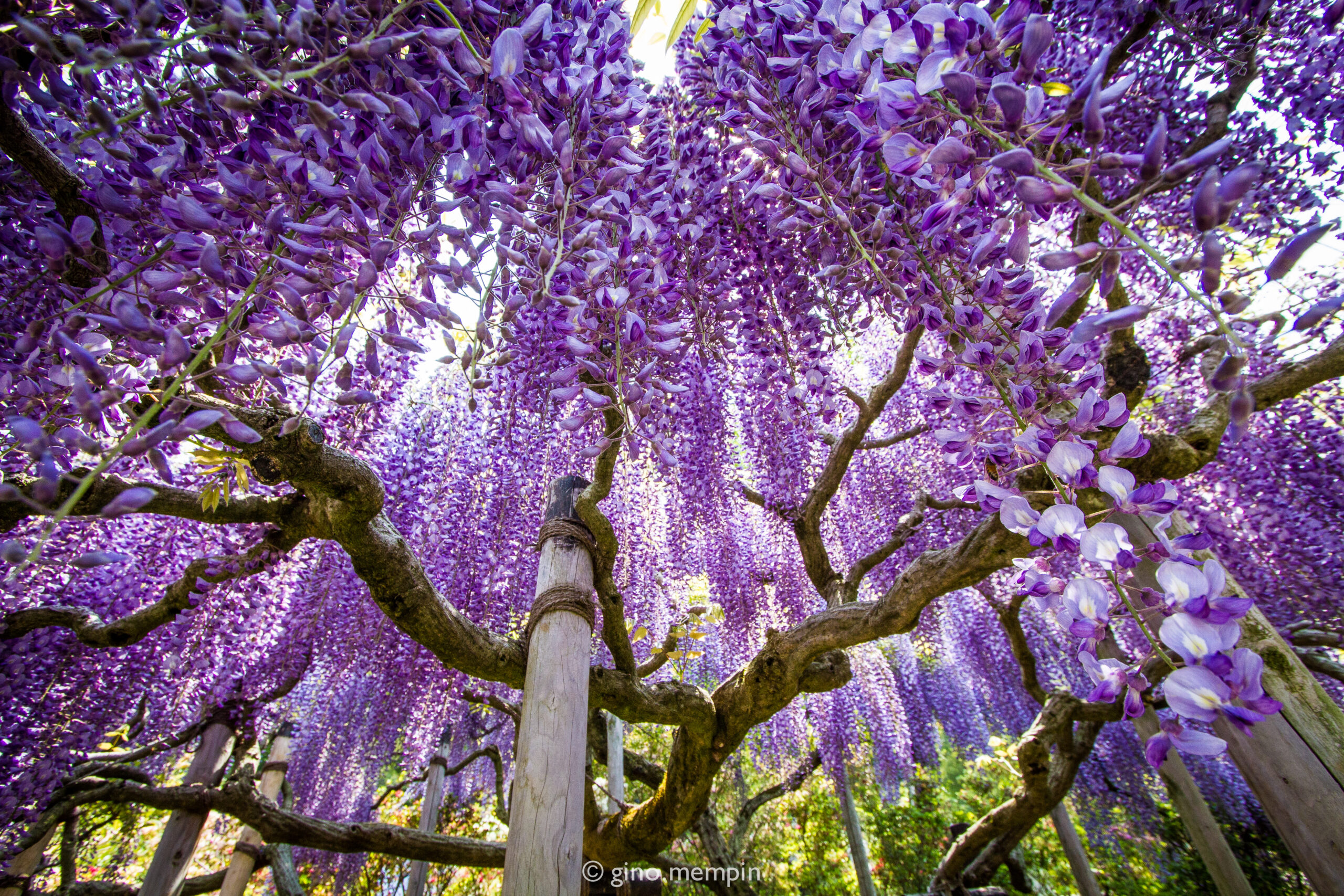In the springtime, Japan becomes a canvas of blooming beauty—cherry blossoms may take center stage, but there’s another floral treasure that quietly steals hearts: wisteria, or fuji (藤) in Japanese. With its delicate, cascading blooms and sweet fragrance, wisteria season brings an enchanting, almost fairytale-like atmosphere to gardens and parks around the country.
What is Wisteria?
Wisteria is a climbing plant known for its long, drooping clusters of flowers that come in shades of purple, blue, pink, and white. The flowers hang like chandeliers from trellises and archways, creating tunnels of color and scent that attract both people and pollinators.
Wisteria is part of the legume family, and while the plant can grow in many parts of the world, Japan’s cultivation techniques—especially the art of training wisteria to drape over pergolas—have made it uniquely beautiful here.
Symbolism and Meaning of Wisteria in Japan
In Japanese culture, wisteria (fuji) symbolizes love, tenderness, and longevity. It’s often associated with humility and devotion, as the hanging flowers seem to bow gently toward the earth.
Wisteria is also a common motif in kimono designs, kabuki theatre, and family crests (kamon). The elegant and flowing nature of the plant has made it a symbol of gracefulness throughout Japanese history.
It also appears in pop-culture as a symbol of love and protection, as seen in Demon Slayer (鬼滅の刃) in which the demons cannot approach the Wisteria flowers!
Types of Wisteria in Japan
Japan is home to several native varieties of wisteria. Some of the most commonly seen include:
- Noda Fuji (ノダフジ): The most typical purple wisteria, known for its long flower clusters and strong fragrance.
- Shiro Fuji (シロフジ): White wisteria, often seen in elegant garden displays.
- Yae Fuji (ヤエフジ): Double-petaled wisteria, creating a fuller, fluffier look.
- Pink Wisteria (ベニフジ / 紅藤): Rare and especially striking with soft, pastel pink blooms.
These varieties are often cultivated to bloom on arches, tunnels, or domes, creating stunning photo-worthy scenes.
When is Wisteria Season in Japan?
Wisteria typically blooms from mid-April to early May, depending on the region and weather. In general:
- Southern Japan (Kyushu, Kansai): Mid to late April
- Central Japan (Tokyo, Chubu): Late April to early May
- Northern Japan (Tohoku): Early to mid-May
If you’re planning a spring trip and want to catch these flowers at their best, late April is usually your safest bet!
Where to See Wisteria in Japan
There are many gardens and parks throughout Japan that showcase wisteria beautifully. Here are some of the best spots to enjoy them:
Kanto (Tokyo) Area – Kameido Tenjin Shrine (亀戸天神社)
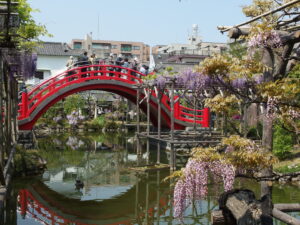
📍 Koto Ward, Tokyo
🗓 Best viewing: Late April to early May
This shrine is famous for its purple wisteria hanging over arched bridges and reflecting in the ponds below. The Kameido Wisteria Festival (藤まつり) is held every spring, attracting visitors who come to stroll through the blossoms and enjoy the festive food stalls.
Kansai Area – Byakugō-ji Temple (白毫寺), Nara
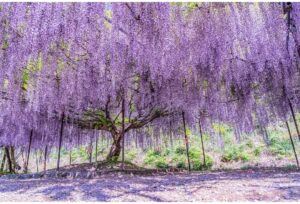
📍 Nara City, Nara Prefecture
🗓 Best viewing: Late April
While Nara is famous for its deer and temples, Byakugō-ji Temple is a hidden gem when it comes to wisteria. It’s home to the ‘Giant Wisteria of Byakugō-ji’, an ancient tree with beautiful pinkish-purple flowers that bloom against a serene temple backdrop.
Kyushu – Kawachi Fujien Wisteria Garden (河内藤園), Fukuoka
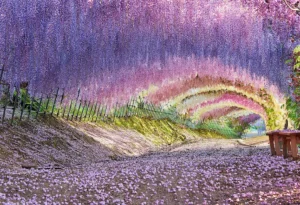
📍 Kitakyushu City, Fukuoka Prefecture
🗓 Best viewing: Mid to late April
Perhaps Japan’s most famous wisteria destination, Kawachi Fujien is home to two spectacular wisteria tunnels and a wisteria dome, with over 20 varieties in bloom. Note: This garden uses a pre-reservation ticket system during peak season, so be sure to book in advance.
Tochigi – Ashikaga Flower Park (あしかがフラワーパーク)
📍 Ashikaga, Tochigi Prefecture
🗓 Best viewing: Mid-April to early May
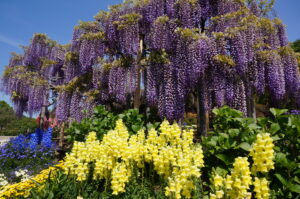
Ashikaga Flower Park is a must-visit for wisteria lovers. The park features a 150-year-old Great Wisteria Tree, long flower tunnels, and even rare yellow and white varieties. When illuminated at night, the blossoms take on a magical, glowing effect.
Kyoto – Toba Water Treatment Plant Wisteria Tunnel (鳥羽の藤)
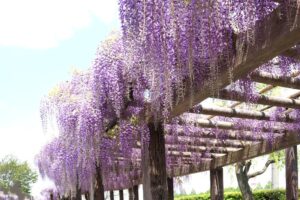
📍 Kyoto City, Kyoto Prefecture
🗓 Best viewing: Late April
This is a lesser-known but wonderful spot for locals. The wisteria trellis walkway at the Toba plant is open to the public for a limited time each spring, with over 100 meters of blooming vines.
Final Tips for Enjoying Wisteria Season
- Check bloom forecasts: Like cherry blossoms, wisteria bloom timing varies each year. Local tourism sites usually post updates in early April.
- Weekday visits are best: Popular spots like Ashikaga and Kawachi Fujien can get crowded, so aim for weekday mornings.
- Book ahead: Some parks, especially Kawachi Fujien, require reservations due to their popularity.
- Don’t rush—take in the scent: One of the joys of wisteria season is not just the view, but the sweet, delicate fragrance in the air.
Whether you’re on a temple stroll in Nara or wandering under a tunnel of blossoms in Fukuoka, Japan’s wisteria season is a truly magical part of spring. These cascading blooms invite you to slow down, breathe deeply, and take in a gentler side of Japan’s natural beauty.
Let yourself be charmed by the wisteria flowers—you might just fall in love with spring all over again!

